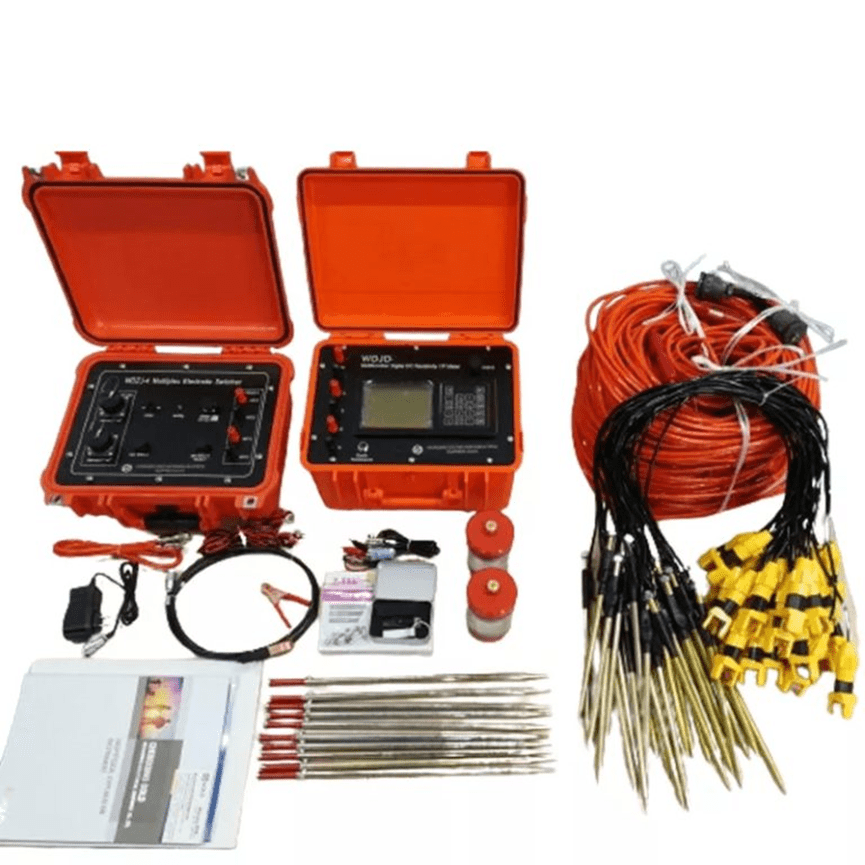Welcome to Geotech!

Core Differences Between Centralized and Distributed High-Density Electrical Methods
Meta Description
This technical analysis compares Centralized and Distributed high-density electrical methods, covering application scenarios, data processing architectures, and equipment costs to support scientific decision-making in geophysical exploration.

I. Application Scenarios Comparison
High-density electrical methods (HDEM) are pivotal in modern geophysical exploration, with two primary implementations exhibiting distinct application scenarios:
1. Centralized High-Density Electrical Method
Key Applications:
• Large-scale geological surveys (mineral resource assessment, regional hydrogeological investigations)
• Long-distance profile measurements (railway/highway engineering geology surveys)
• Deep geological structure detection (depth > 200 meters)
Technical Advantages:
Centralized equipment deployment enables regional coverage up to 10 km², supporting parallel multi-task measurements in a single setup, significantly enhancing efficiency for large-scale explorations.
2. Distributed High-Density Electrical Method
Key Applications:
• Urban subsurface space detection (pipeline localization, metro engineering monitoring)
• Precision geological modeling (landslide monitoring, archaeological site surveys)
• Shallow high-resolution measurements (depth < 50 meters)
Technical Advantages:
Distributed node design achieves centimeter-level positioning accuracy, ideal for localized high-resolution detection in complex urban environments.
II. Data Processing Architectures
The data processing frameworks of these two methodologies directly impact system performance and applicability:
1. Centralized Architecture Features
● Centralized Processing: All measurement data transmitted via fiber/wireless networks to a central server.
● Hardware Requirements: High-performance GPU clusters for terabyte-level data stream processing.
● Latency Profile: Suitable for non-real-time batch tasks (e.g., regional geological modeling).
2. Distributed Architecture Features
● Edge Computing: FPGA chips integrated into each measurement node for local data preprocessing.
● Transmission Optimization: 80% data compression rate minimizes bandwidth requirements.
● Real-Time Capability: Supports millisecond-level anomaly response (e.g., real-time pipeline leakage monitoring).
III. Equipment Configuration & Cost Analysis
1. Centralized System Cost Structure
| Component | Cost Share | Technical Specifications |
|---|---|---|
| Central Controller | 45% | 128-channel synchronous acquisition |
| Electrode Array | 30% | Stainless steel electrodes (5-20m adjustable spacing) |
| Data Transmission | 25% | Industrial-grade wireless mesh network |
Economic Advantage: Single system serves multiple projects with significant marginal cost reduction over time.
2. Distributed System Cost Structure
| Component | Cost Share | Technical Specifications |
|---|---|---|
| Smart Nodes | 60% | ARM processor + 4G communication module |
| Positioning System | 25% | Centimeter-level RTK accuracy |
| Power System | 15% | Solar + lithium battery hybrid supply |
Deployment Advantage: Modular design enables on-demand scalability, ideal for short-term high-precision projects.
IV. Technical Selection Decision Framework
Decision Tree for Method Selection:
markdownRequire real-time data feedback?
Yes → Choose Distributed High-Density Electrical Method
No → Proceed to next criterion
Measurement depth > 100 meters?
Yes → Choose Centralized High-Density Electrical Method
No → Select based on budget (Distributed: higher unit-area cost but superior accuracy)
-1.png)

